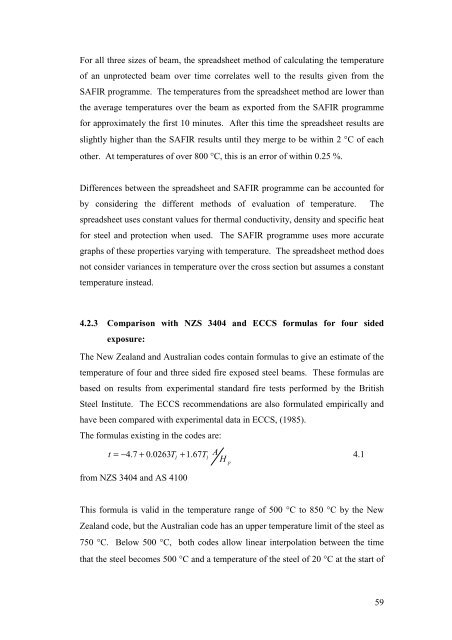FIRE DESIGN OF STEEL MEMBERS - Civil and Natural Resources ...
FIRE DESIGN OF STEEL MEMBERS - Civil and Natural Resources ...
FIRE DESIGN OF STEEL MEMBERS - Civil and Natural Resources ...
Create successful ePaper yourself
Turn your PDF publications into a flip-book with our unique Google optimized e-Paper software.
For all three sizes of beam, the spreadsheet method of calculating the temperature<br />
of an unprotected beam over time correlates well to the results given from the<br />
SAFIR programme. The temperatures from the spreadsheet method are lower than<br />
the average temperatures over the beam as exported from the SAFIR programme<br />
for approximately the first 10 minutes. After this time the spreadsheet results are<br />
slightly higher than the SAFIR results until they merge to be within 2 °C of each<br />
other. At temperatures of over 800 °C, this is an error of within 0.25 %.<br />
Differences between the spreadsheet <strong>and</strong> SAFIR programme can be accounted for<br />
by considering the different methods of evaluation of temperature. The<br />
spreadsheet uses constant values for thermal conductivity, density <strong>and</strong> specific heat<br />
for steel <strong>and</strong> protection when used. The SAFIR programme uses more accurate<br />
graphs of these properties varying with temperature. The spreadsheet method does<br />
not consider variances in temperature over the cross section but assumes a constant<br />
temperature instead.<br />
4.2.3 Comparison with NZS 3404 <strong>and</strong> ECCS formulas for four sided<br />
exposure:<br />
The New Zeal<strong>and</strong> <strong>and</strong> Australian codes contain formulas to give an estimate of the<br />
temperature of four <strong>and</strong> three sided fire exposed steel beams. These formulas are<br />
based on results from experimental st<strong>and</strong>ard fire tests performed by the British<br />
Steel Institute. The ECCS recommendations are also formulated empirically <strong>and</strong><br />
have been compared with experimental data in ECCS, (1985).<br />
The formulas existing in the codes are:<br />
t = −4 .7 + 0.0263T<br />
A<br />
l<br />
+ 1. 67Tl<br />
4.1<br />
H<br />
from NZS 3404 <strong>and</strong> AS 4100<br />
p<br />
This formula is valid in the temperature range of 500 °C to 850 °C by the New<br />
Zeal<strong>and</strong> code, but the Australian code has an upper temperature limit of the steel as<br />
750 °C. Below 500 °C, both codes allow linear interpolation between the time<br />
that the steel becomes 500 °C <strong>and</strong> a temperature of the steel of 20 °C at the start of<br />
59
















